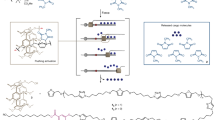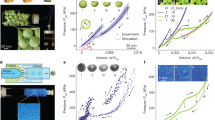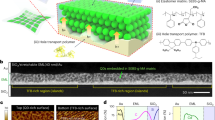Abstract
Metamaterials are artificial substances that are structurally engineered to have properties not typically found in nature. To date, almost all metamaterials have been made from inorganic materials such as silicon and copper1,2, which have unusual electromagnetic or acoustic properties1,2,3,4,5 that allow them to be used, for example, as invisible cloaks6,7,8,9, superlenses10,11,12 or super absorbers for sound13. Here, we show that metamaterials with unusual mechanical properties can be prepared using DNA as a building block. We used a polymerase enzyme to elongate DNA chains and weave them non-covalently into a hydrogel. The resulting material, which we term a meta-hydrogel, has liquid-like properties when taken out of water and solid-like properties when in water. Moreover, upon the addition of water, and after complete deformation, the hydrogel can be made to return to its original shape. The meta-hydrogel has a hierarchical internal structure and, as an example of its potential applications, we use it to create an electric circuit that uses water as a switch.
This is a preview of subscription content, access via your institution
Access options
Subscribe to this journal
Receive 12 print issues and online access
$259.00 per year
only $21.58 per issue
Buy this article
- Purchase on Springer Link
- Instant access to full article PDF
Prices may be subject to local taxes which are calculated during checkout





Similar content being viewed by others
References
Shelby, R. A., Smith, D. R. & Schultz, S. Experimental verification of a negative index of refraction. Science 292, 77–79 (2001).
Liu, Y. M. & Zhang, X. Metamaterials: a new frontier of science and technology. Chem. Soc. Rev. 40, 2494–2507 (2011).
Pendry, J. B., Holden, A. J., Stewart, W. J. & Youngs, I. Extremely low frequency plasmons in metallic mesostructures. Phys. Rev. Lett. 76, 4773–4776 (1996).
Smith, D. R., Padilla, W. J., Vier, D. C., Nemat-Nasser, S. C. & Schultz, S. Composite medium with simultaneously negative permeability and permittivity. Phys. Rev. Lett. 84, 4184–4187 (2000).
Smith, D. R., Pendry, J. B. & Wiltshire, M. C. K. Metamaterials and negative refractive index. Science 305, 788–792 (2004).
Alu, A. & Engheta, N. Achieving transparency with plasmonic and metamaterial coatings. Phys. Rev. E 72, 016623 (2005).
Schurig, D. et al. Metamaterial electromagnetic cloak at microwave frequencies. Science 314, 977–980 (2006).
Liu, R. et al. Broadband ground-plane cloak. Science 323, 366–369 (2009).
Fridman, M., Farsi, A., Okawachi, Y. & Gaeta, A. L. Demonstration of temporal cloaking. Nature 481, 62–65 (2012).
Grbic, A. & Eleftheriades, G. V. Overcoming the diffraction limit with a planar left-handed transmission-line lens. Phys. Rev. Lett. 92, 117403 (2004).
Fang, N., Lee, H., Sun, C. & Zhang, X. Sub-diffraction-limited optical imaging with a silver superlens. Science 308, 534–537 (2005).
Rogers, E. T. F. et al. A super-oscillatory lens optical microscope for subwavelength imaging. Nature Mater. 11, 432–435 (2012).
Mei, J. et al. Dark acoustic metamaterials as super absorbers for low-frequency sound. Nature Commun. 3, 756 (2012).
Roh, Y. H., Ruiz, R. C. H., Peng, S. M., Lee, J. B. & Luo, D. Engineering DNA-based functional materials. Chem. Soc. Rev. 40, 5730–5744 (2011).
Tan, S. J., Campolongo, M. J., Luo, D. & Cheng, W. L. Building plasmonic nanostructures with DNA. Nature Nanotech. 6, 268–276 (2011).
Li, Y. G. et al. Controlled assembly of dendrimer-like DNA. Nature Mater. 3, 38–42 (2004).
Li, Y. G., Cu, Y. T. H. & Luo, D. Multiplexed detection of pathogen DNA with DNA-based fluorescence nanobarcodes. Nature Biotechnol. 23, 885–889 (2005).
Um, S. H. et al. Enzyme-catalysed assembly of DNA hydrogel. Nature Mater. 5, 797–801 (2006).
Lee, J. B. et al. Multifunctional nanoarchitectures from DNA-based ABC monomers. Nature Nanotech. 4, 430–436 (2009).
Park, N., Um, S. H., Funabashi, H., Xu, J. F. & Luo, D. A cell-free protein-producing gel. Nature Mater. 8, 432–437 (2009).
Feng, X. L. et al. Fluorescence logic-signal-based multiplex detection of nucleases with the assembly of a cationic conjugated polymer and branched DNA. Angew. Chem. Int. Ed. 48, 5316–5321 (2009).
Sil, D., Lee, J. B., Luo, D., Holowka, D. & Baird, B. Trivalent ligands with rigid DNA spacers reveal structural requirements for IgE receptor signaling in RBL mast cells. ACS Chem. Biol. 2, 674–684 (2007).
Cheng, E. J. et al. A pH-triggered, fast-responding DNA hydrogel. Angew. Chem. Int. Ed. 48, 7660–7663 (2009).
Rattanakiat, S., Nishikawa, M., Funabashi, H., Luo, D. & Takakura, Y. The assembly of a short linear natural cytosine–phosphate–guanine DNA into dendritic structures and its effect on immunostimulatory activity. Biomaterials 30, 5701–5706 (2009).
Dean, F. B., Nelson, J. R., Giesler, T. L. & Lasken, R. S. Rapid amplification of plasmid and phage DNA using phi29 DNA polymerase and multiply-primed rolling circle amplification. Genome Res. 11, 1095–1099 (2001).
Lee, J. B., Shai, A. S., Campolongo, M. J., Park, N. & Luo, D. Three-dimensional structure and thermal stability studies of DNA nanostructures by energy transfer spectroscopy. ChemPhysChem 11, 2081–2084 (2010).
Roh, Y. H. et al. Photocrosslinked DNA nanospheres for drug delivery. Macromol. Rapid Commun. 31, 1207–1211 (2010).
Cauich-Rodriguez, J. V., Deb, S. & Smith, R. Effect of cross-linking agents on the dynamic mechanical properties of hydrogel blends of poly(acrylic acid)–poly(vinyl alcohol vinyl acetate). Biomaterials 17, 2259–2264 (1996).
Xing, Y. Z. et al. Self-assembled DNA hydrogels with designable thermal and enzymatic responsiveness. Adv. Mater. 23, 1117–1121 (2011).
Acknowledgements
The authors thank L. Archer and R. Mallavajula for helping with the mechanical test and C. Hui for insightful discussions. The authors also thank J. March, J. Hunter and T. Walter for proofreading this manuscript and Z. Li for discussions and suggestions. L.C. acknowledges support from the CAS/SAFEA International Partnership Program for Creative Research Teams. The present work was partially supported by grants from the United States Department of Agriculture (USDA) and the Department of Defense (DOD).
Author information
Authors and Affiliations
Contributions
J.B.L., S.P. and D.L. designed the experiments. J.B.L., S.P., Y.H.R., H.F., N.P. and E.R. carried out the experiments. J.B.L., S.P., Y.H.R., H.F., D.Y., L.C., R.L., M.W. and D.L. contributed to the data analysis. J.B.L., S.P., Y.H.R., D.Y., R.L. and D.L. wrote the manuscript.
Corresponding author
Ethics declarations
Competing interests
The authors declare no competing financial interests.
Supplementary information
Supplementary information
Supplementary information (PDF 2374 kb)
Supplementary movie S1
Supplementary movie S1 (WMV 2294 kb)
Rights and permissions
About this article
Cite this article
Lee, J., Peng, S., Yang, D. et al. A mechanical metamaterial made from a DNA hydrogel. Nature Nanotech 7, 816–820 (2012). https://doi.org/10.1038/nnano.2012.211
Received:
Accepted:
Published:
Issue Date:
DOI: https://doi.org/10.1038/nnano.2012.211
This article is cited by
-
Stimuli-responsive DNA-based hydrogels for biosensing applications
Journal of Nanobiotechnology (2022)
-
Soft materials evolution and revolution
Nature Materials (2022)
-
A hydrogel-based mechanical metamaterial for the interferometric profiling of extracellular vesicles in patient samples
Nature Biomedical Engineering (2022)
-
Coordinated motion of molecular motors on DNA chains with branch topology
Acta Mechanica Sinica (2022)



